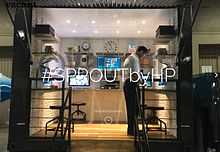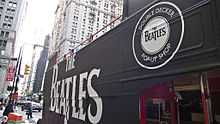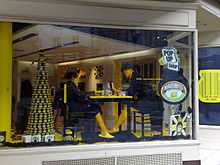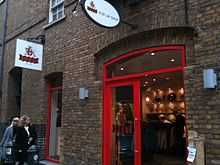Pop-up retail





Pop-up retail, also known as pop-up store (pop-up shop in the UK, Australia and Ireland) or flash retailing, is a trend of opening short-term sales spaces in Canada, the United States,[1][2] the United Kingdom and Australia.[3]
History
Vacant of Los Angeles, California is the first company to develop the concept of pop-up retail or temporary retail shops. In 1999, company staff wondered whether consumers would line up to purchase limited edition products from niche retailers. Once the products were sold out, usually within a matter of hours, the store would be closed until the owner received more product and would then reopen the store. This led Vacant to think about closing the store permanently after the merchandise has been sold and moving it to another targeted destination, since consumers were traveling long distances to the niche retailers to purchase items. The company still provides pop-up retailing and brand marketing today. Vacant opened its second shop in New York City in February 2003,[4] with Dr. Martens as a sponsor.[5][6][7][8]
Song Airlines opened a pop-up shop in New York City later in 2003. Comme des Garçons opened, for one year, a pop-up shop in 2004 with the 'Guerrilla Shop' tag. Popuphood (Oakland, California) and Renew (Newcastle, Australia) are two examples of DIY urbanism using Popups. Popuphood pioneered rethinking retail as a revitalization strategy and economic development tool for cities.
Other brands that have developed pop-up shops as part of their campaign include Target Corporation, Kate Spade, Gucci, Louis Vuitton and Colette. Incubator programmes employing pop-up retail include BOXPARK[9] in London and PopupHood [10] in Oakland, California.
Concept
A pop-up retail space is a venue that is temporary: the space could be a sample sale one day and host a private cocktail party the next evening. The trend involves "popping up" one day, then disappearing anywhere from one day to several weeks later. These shops, while small and temporary, can build up interest by consumer exposure. Pop-up retail allows a company to create a unique environment that engages their customers and generates a feeling of relevance and interactivity. They are often used by marketers for seasonal items such as Halloween costumes and decorations, Christmas gifts and Christmas trees, or fireworks.[1]
There are different benefits to popups such as marketing, testing products, locations, or markets, and as a low cost way to start a business. Some pop up shops, such as Ricky's and other Halloween stores, are seasonal, allowing brands to capture foot traffic without committing to a long term lease.[11] Other brands use pop-ups to spark creative engagement, such as Marc Jacobs Tweet Shop's exchange of "social currency" for free product.[12]
Halloween stores
A Halloween store is a pop-up store or superstore that sells costumes and decorations for Halloween. They are very common in the United States and to some extent Canada, where the holiday and celebration preceding it are second only to Christmas in popularity and consumer spending but are not very common in the UK. Hundreds of stores are open during the season each year.
The stores are unique in that they serve a seasonal niche market, and nearly all of them are open only during September and October. They typically have a lease of around three months, hiring managers in July and doing store setup in late August, with a teardown (often after a very short closeout sale) in early November. The stores typically open around Labor Day in the US (also Labour Day in Canada), but this varies by a week or two in either direction. Not all of the stores from the same retailer will open at the same time because of logistics.
The stores typically occupy a large anchor store in a strip mall, and change locations each year, based on whatever stores are vacant and available each autumn. While many operate as a retail chain, some stores may be run by franchisees, selling merchandise on consignment. Some have a combination of both types of stores.
Stores are typically located in middle-class areas, where residents and shoppers have higher disposable incomes to spend on Halloween parties and costumes. The annual temporary specialty stores succeed because they offer a much wider and more unique variety of items than what is seen at other retailers such as discount stores or department stores and because they tend to offer items of higher quality and detail (and profit), compared to the inexpensive (or often downright cheap) costumes at drugstores and supermarkets. The stores typically sell large and unusual items like animatronic witches and other ghoulish characters, and various other stage props; as well as a range of makeup, wigs, fog machines, strobe lights, blacklights, and other items sold at regular stores.
Because the stores are only temporary, they often use employees as sign wavers on a nearby street corner to attract the attention of passing motorists. In place of store signs, they display large banners, which can be stored and reused the following year. Telephone numbers are typically disconnected and not reused, and online mapping services often show locations of the previous year. Because of this, the only reliable source of store addresses and contact information is each company's website, but these are usually posted only after each store opens, possibly to avoid alerting competitors.
There are other shops or stores that exist in a similar manner to Halloween stores. One example are calendar stores that occupy either a mall storefront or large kiosk area between early November and late January. Another type are temporary fireworks stores that operate in many areas of the US on a similar model, leading up to the Fourth of July and, in warm weather areas, to New Years Eve.
References
- ↑ 1.0 1.1 Gregory, Sean (November 6, 2009). "Why Pop-Up Shops Are Hot". Time. Retrieved November 22, 2009.
Ricky's Costume Superstore in New York City was ready for Halloween
- ↑ Clifford, Stephanie (October 30, 2008). "Hanging Out at a Mall for the Holidays". The New York Times. Retrieved November 22, 2009.
The Haute Spot is a so-called pop-up concept, meaning that the store is not permanent. The location will be open Nov. 28 through Dec. 26.
- ↑ Smith, Stephen (December 4, 2009). "The pop-up shopping phenomenon". Newsnight (London: BBC Two). Retrieved January 17, 2010.
- ↑ Billy Gray (December, 2012) New York Observer. On 10th Anniversary of First NYC Pop-Up, Retailers Look Back.http://commercialobserver.com/2012/12/on-10th-anniversary-of-first-nyc-pop-up-retailers-look-back/
- ↑ Robb Mandelbaum (June, 2013) New York Times Magazine. Who Made That? Pop-up Store. http://www.nytimes.com/packages/html/magazine/2013/innovations-issue/#/?part=popupstore
- ↑ Lazarovic, Sarah (March, 2003) Elle Canada. Are pop-up stores the hip new face of retail or a clever marketing ploy to fight consumer fatigue? http://www.ellecanada.com/living/shop-n-go/a/24980
- ↑ Berwick, Carly (November, 2003) Travel & Leisure Reports: Fashion Forward http://www.travelandleisure.com/articles/fashion-forward
- ↑ Tzortzis, Andreas (October, 2004) Pop-up stores: here today, gone tomorrow http://www.nytimes.com/2004/10/24/business/worldbusiness/24iht-popups25.html?pagewanted=all
- ↑ http://www.boxpark.co.uk/
- ↑ http://www.popuphood.com/
- ↑ Bloomberg TV (May, 2014). An Inside Look at the Pop-Up Retail Phenomenon. http://www.bloomberg.com/video/an-inside-look-at-the-pop-up-retail-phenomenon-1nZwFqJ0Ra~ZU3vgwGlkNg.html
- ↑ Gonzalez, Melissa (December, 2014). The Pop-Up Paradigm: How Brands Build Human Connections in a Digital Age. http://www.amazon.com/The-Pop-Up-Paradigm-Connections-ebook/dp/B00P04ZYRA
External links
| Wikimedia Commons has media related to Pop-up retail. |
- Pop Up Shop Calendar - NYC
- Daily news on the UK's pop up retail industry
- The History of the Pop Up Shop
- Miami Herald: Boo! Pop-up stores popping up all over for the holidays
- BusinessWeek: The Staying Power of Pop-Up Stores
- USA Today: Pop-up stores offer bridge to better times
- Bostinno: A Popup Directory is Launched
- WSJ: Stores That Can't Stay
- The Pop-Up Space Finder
- Arkitainer: Pop-up retail in London
- Popup Shops & Cafes at Dalegate Market
- The Ultimate Guide to Opening a Pop Up Shop
- The Pop-Up Series: Store Concept
- No Space Too Small, No Lease Too Short
- An Look Inside the Pop-Up Retail phenomenon